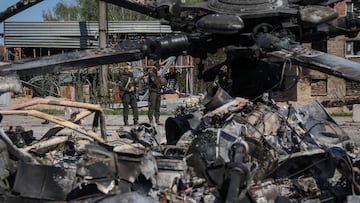Why hasn’t the Russian Air Force been able to dominate Ukraine?
Nearly three months after Russia first invaded, the failure to secure aerial control has cost Moscow severely as Western powers aid the resistance effort.

Shortly before Russian forces invaded Ukraine back in February many outside observers predicted that the invaders’ military strength would allow them to sweep through the country and capture Kyiv in a matter of weeks.
However that has proved far from the reality and the Russian military has failed to secure the aerial control expected. Russia boasts the world’s second-largest air force, and a highly advanced one, but it has been kept at bay by resolute Ukrainian resistance.
On Monday The New York Times reported that, according to the US Department of Defense, Ukraine “continues to fly its own fighter jets and attack aircraft against Russian troops.”
Russia appeared to have made a crucial breakthrough when they captured the Ukrainian airport of Gostomel, just north of the capital city of Kyiv, but Ukrainian forces had regained control of the airport by 2 April.
Western weapons prove decisive
While they have been extremely reluctant to provoke Russia into a retaliatory attack, NATO countries have offered military support to Ukraine in the form of weapons and vehicles. One of the most crucial additions have been the portable air defence systems, such as the US-made Stinger missile, which can be fired by a single operator.
This has allowed the defending forces to prevent Russia from gaining dominance in the air, and the portability of the weapons allows for more flexibility in their strategy.
Pavel Luzin, an expert on the Russian military from the Jamestown Foundation explains: “Western supplies of MANPADs [Man-portable air-defence systems] and other types of air defence systems allowed Ukraine to increase and improve its capabilities.”
During the early weeks of the Russian invasion, Ukraine did not have these anti-aircraft weapons and their introduction has undoubtedly bolster Ukrainian defences. The United States alone has designated $40 billion in relief funds for Ukraine. Roughly $6 billion of that will go towards military aid, with another $3.8 billion worth of weapons from American stockpiles to bolster Ukrainian supplies.
Russia fails to make the most of initial advantages
However another major factor could be the inadequacy of Russian weapons, which some analysts have suggested are now outdated an unsuited for the type of mass invasion planned by President Putin.
With their resources dwindling, Russian forces have reportedly been equipped with Soviet-era weapons, some of which has been in storage since the 1970s. The failure to secure a rapid victory in Ukraine has thrown out the Kremlin’s preparations and there has been numerous reports of forced withdrawals to allow troops to restock and reorganise in the Donbas region.
William Alberque, director at the International Institute for Strategic Studies, has claimed that Russian military tactics have also been rather outdated, preventing them from dominating the skies.
He said: “Instead of working to control the skies, Russia’s air force has mainly provided air support to ground troops or bombed Ukrainian cities. In this it has followed the traditional tactics of a continental power that favours ground forces.”






